Motivational Theories for Increasing Employee Engagement
VerifiedAdded on 2022/12/09
|9
|3249
|283
AI Summary
This essay discusses various motivational theories that can be used to increase employee engagement in the workplace. It explores Maslow's hierarchy of needs, Alderfer's ERG theory, Herzberg's Two Factor theory, Adams' equity theory, and McGregor's participation theory. By understanding and implementing these theories, managers can effectively motivate their employees and improve productivity.
Contribute Materials
Your contribution can guide someone’s learning journey. Share your
documents today.

Motivational theories
“Key motivational theories in increasing employee engagement”
“Key motivational theories in increasing employee engagement”
Secure Best Marks with AI Grader
Need help grading? Try our AI Grader for instant feedback on your assignments.
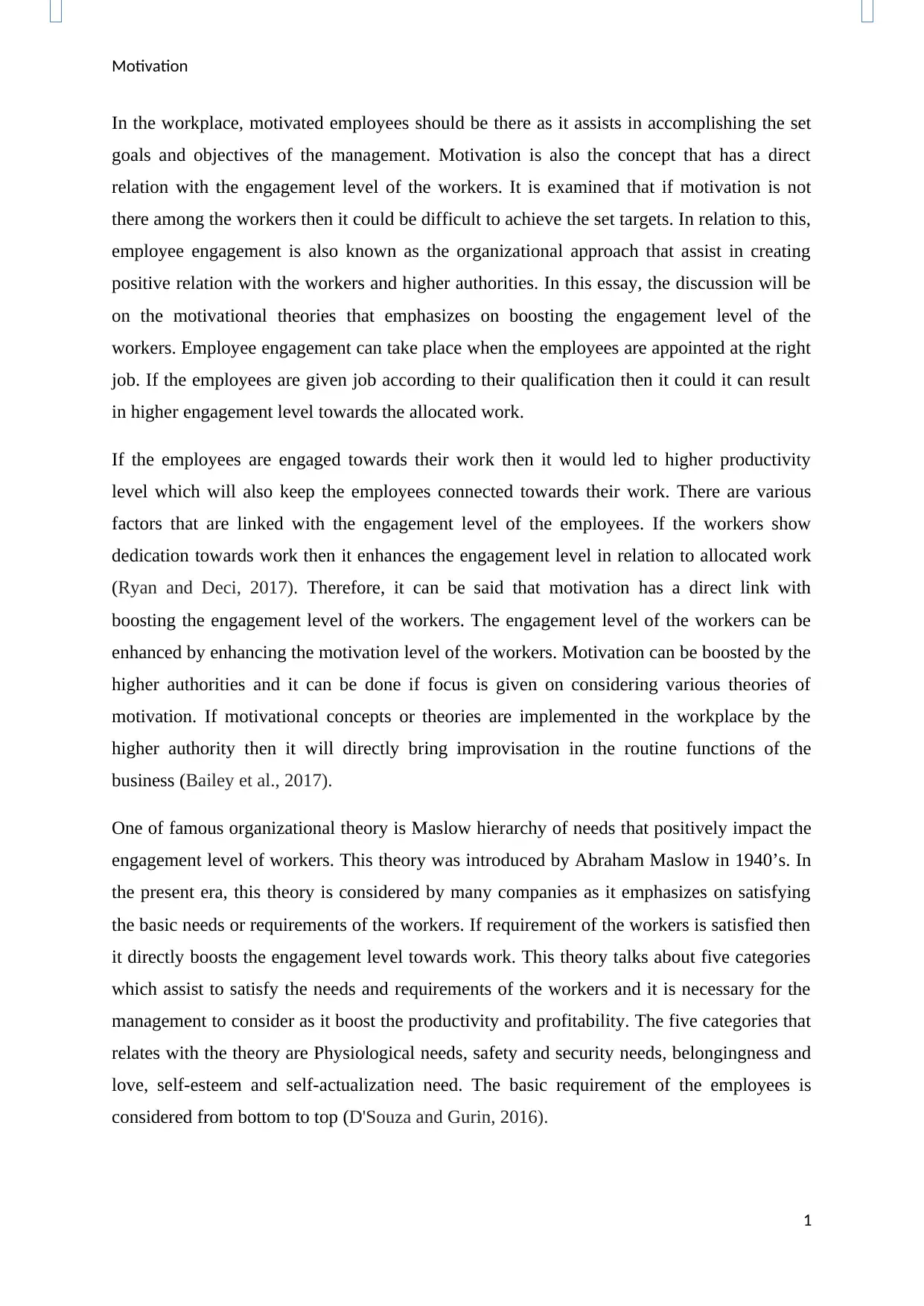
Motivation
In the workplace, motivated employees should be there as it assists in accomplishing the set
goals and objectives of the management. Motivation is also the concept that has a direct
relation with the engagement level of the workers. It is examined that if motivation is not
there among the workers then it could be difficult to achieve the set targets. In relation to this,
employee engagement is also known as the organizational approach that assist in creating
positive relation with the workers and higher authorities. In this essay, the discussion will be
on the motivational theories that emphasizes on boosting the engagement level of the
workers. Employee engagement can take place when the employees are appointed at the right
job. If the employees are given job according to their qualification then it could it can result
in higher engagement level towards the allocated work.
If the employees are engaged towards their work then it would led to higher productivity
level which will also keep the employees connected towards their work. There are various
factors that are linked with the engagement level of the employees. If the workers show
dedication towards work then it enhances the engagement level in relation to allocated work
(Ryan and Deci, 2017). Therefore, it can be said that motivation has a direct link with
boosting the engagement level of the workers. The engagement level of the workers can be
enhanced by enhancing the motivation level of the workers. Motivation can be boosted by the
higher authorities and it can be done if focus is given on considering various theories of
motivation. If motivational concepts or theories are implemented in the workplace by the
higher authority then it will directly bring improvisation in the routine functions of the
business (Bailey et al., 2017).
One of famous organizational theory is Maslow hierarchy of needs that positively impact the
engagement level of workers. This theory was introduced by Abraham Maslow in 1940’s. In
the present era, this theory is considered by many companies as it emphasizes on satisfying
the basic needs or requirements of the workers. If requirement of the workers is satisfied then
it directly boosts the engagement level towards work. This theory talks about five categories
which assist to satisfy the needs and requirements of the workers and it is necessary for the
management to consider as it boost the productivity and profitability. The five categories that
relates with the theory are Physiological needs, safety and security needs, belongingness and
love, self-esteem and self-actualization need. The basic requirement of the employees is
considered from bottom to top (D'Souza and Gurin, 2016).
1
In the workplace, motivated employees should be there as it assists in accomplishing the set
goals and objectives of the management. Motivation is also the concept that has a direct
relation with the engagement level of the workers. It is examined that if motivation is not
there among the workers then it could be difficult to achieve the set targets. In relation to this,
employee engagement is also known as the organizational approach that assist in creating
positive relation with the workers and higher authorities. In this essay, the discussion will be
on the motivational theories that emphasizes on boosting the engagement level of the
workers. Employee engagement can take place when the employees are appointed at the right
job. If the employees are given job according to their qualification then it could it can result
in higher engagement level towards the allocated work.
If the employees are engaged towards their work then it would led to higher productivity
level which will also keep the employees connected towards their work. There are various
factors that are linked with the engagement level of the employees. If the workers show
dedication towards work then it enhances the engagement level in relation to allocated work
(Ryan and Deci, 2017). Therefore, it can be said that motivation has a direct link with
boosting the engagement level of the workers. The engagement level of the workers can be
enhanced by enhancing the motivation level of the workers. Motivation can be boosted by the
higher authorities and it can be done if focus is given on considering various theories of
motivation. If motivational concepts or theories are implemented in the workplace by the
higher authority then it will directly bring improvisation in the routine functions of the
business (Bailey et al., 2017).
One of famous organizational theory is Maslow hierarchy of needs that positively impact the
engagement level of workers. This theory was introduced by Abraham Maslow in 1940’s. In
the present era, this theory is considered by many companies as it emphasizes on satisfying
the basic needs or requirements of the workers. If requirement of the workers is satisfied then
it directly boosts the engagement level towards work. This theory talks about five categories
which assist to satisfy the needs and requirements of the workers and it is necessary for the
management to consider as it boost the productivity and profitability. The five categories that
relates with the theory are Physiological needs, safety and security needs, belongingness and
love, self-esteem and self-actualization need. The basic requirement of the employees is
considered from bottom to top (D'Souza and Gurin, 2016).
1
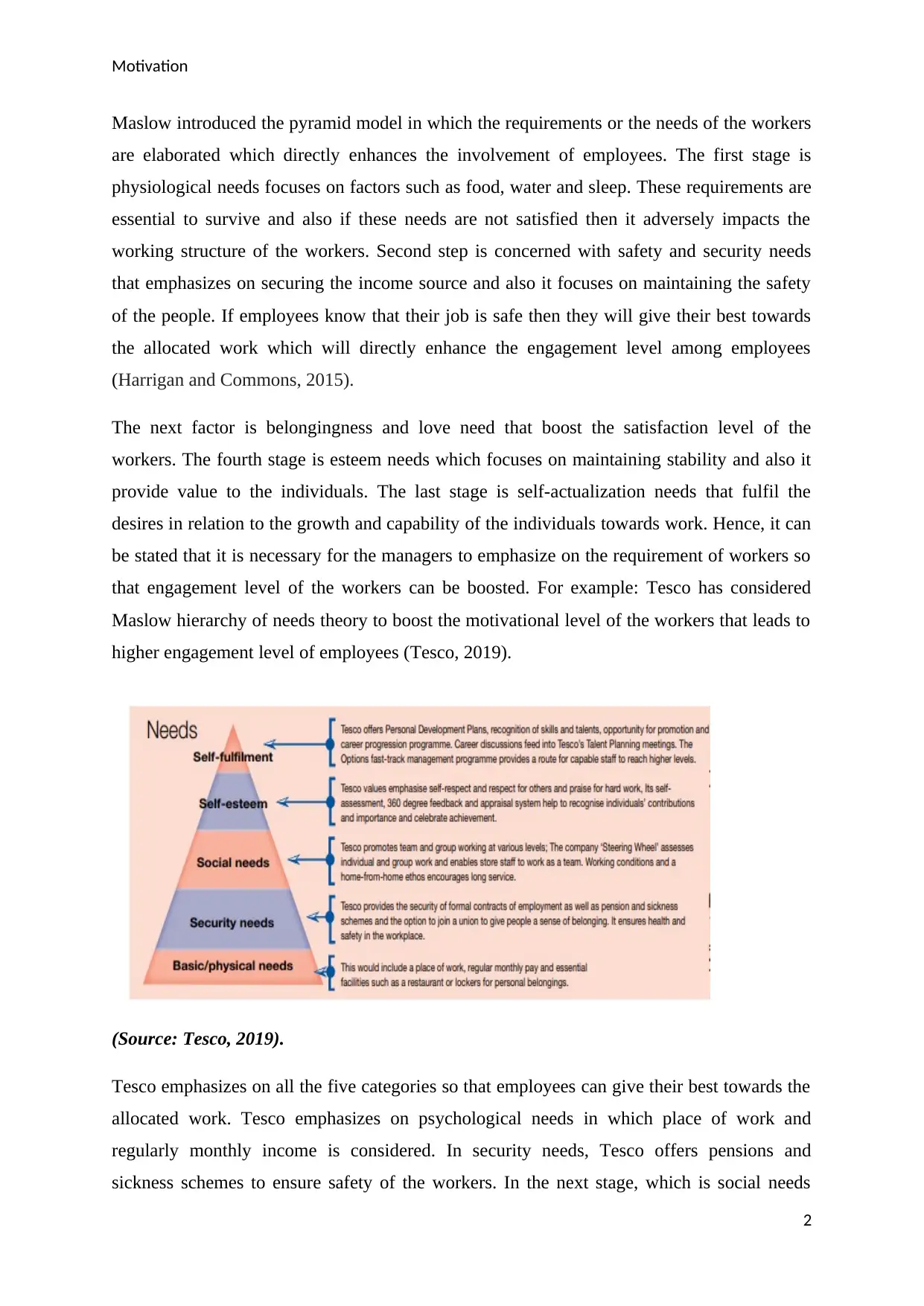
Motivation
Maslow introduced the pyramid model in which the requirements or the needs of the workers
are elaborated which directly enhances the involvement of employees. The first stage is
physiological needs focuses on factors such as food, water and sleep. These requirements are
essential to survive and also if these needs are not satisfied then it adversely impacts the
working structure of the workers. Second step is concerned with safety and security needs
that emphasizes on securing the income source and also it focuses on maintaining the safety
of the people. If employees know that their job is safe then they will give their best towards
the allocated work which will directly enhance the engagement level among employees
(Harrigan and Commons, 2015).
The next factor is belongingness and love need that boost the satisfaction level of the
workers. The fourth stage is esteem needs which focuses on maintaining stability and also it
provide value to the individuals. The last stage is self-actualization needs that fulfil the
desires in relation to the growth and capability of the individuals towards work. Hence, it can
be stated that it is necessary for the managers to emphasize on the requirement of workers so
that engagement level of the workers can be boosted. For example: Tesco has considered
Maslow hierarchy of needs theory to boost the motivational level of the workers that leads to
higher engagement level of employees (Tesco, 2019).
(Source: Tesco, 2019).
Tesco emphasizes on all the five categories so that employees can give their best towards the
allocated work. Tesco emphasizes on psychological needs in which place of work and
regularly monthly income is considered. In security needs, Tesco offers pensions and
sickness schemes to ensure safety of the workers. In the next stage, which is social needs
2
Maslow introduced the pyramid model in which the requirements or the needs of the workers
are elaborated which directly enhances the involvement of employees. The first stage is
physiological needs focuses on factors such as food, water and sleep. These requirements are
essential to survive and also if these needs are not satisfied then it adversely impacts the
working structure of the workers. Second step is concerned with safety and security needs
that emphasizes on securing the income source and also it focuses on maintaining the safety
of the people. If employees know that their job is safe then they will give their best towards
the allocated work which will directly enhance the engagement level among employees
(Harrigan and Commons, 2015).
The next factor is belongingness and love need that boost the satisfaction level of the
workers. The fourth stage is esteem needs which focuses on maintaining stability and also it
provide value to the individuals. The last stage is self-actualization needs that fulfil the
desires in relation to the growth and capability of the individuals towards work. Hence, it can
be stated that it is necessary for the managers to emphasize on the requirement of workers so
that engagement level of the workers can be boosted. For example: Tesco has considered
Maslow hierarchy of needs theory to boost the motivational level of the workers that leads to
higher engagement level of employees (Tesco, 2019).
(Source: Tesco, 2019).
Tesco emphasizes on all the five categories so that employees can give their best towards the
allocated work. Tesco emphasizes on psychological needs in which place of work and
regularly monthly income is considered. In security needs, Tesco offers pensions and
sickness schemes to ensure safety of the workers. In the next stage, which is social needs
2
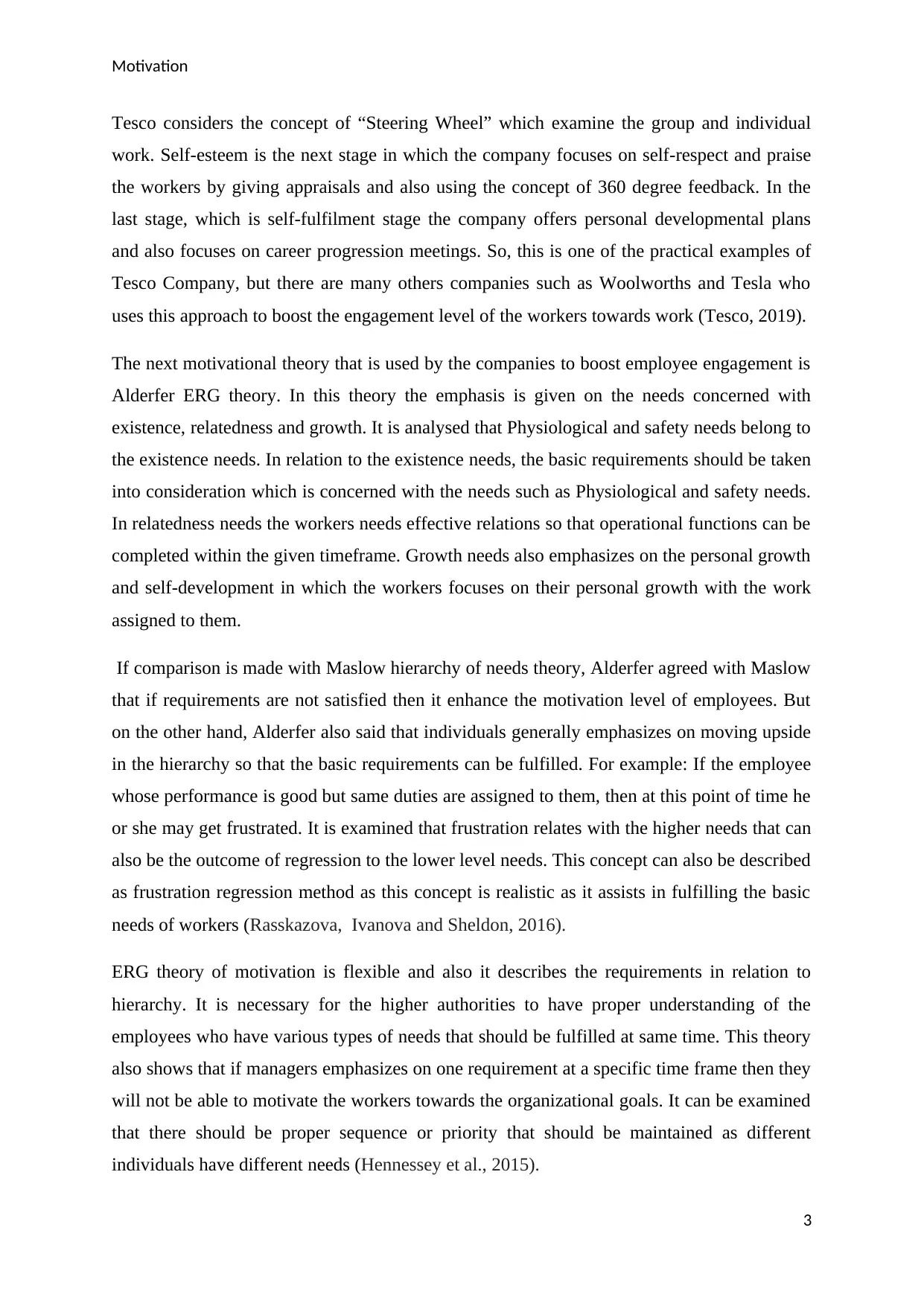
Motivation
Tesco considers the concept of “Steering Wheel” which examine the group and individual
work. Self-esteem is the next stage in which the company focuses on self-respect and praise
the workers by giving appraisals and also using the concept of 360 degree feedback. In the
last stage, which is self-fulfilment stage the company offers personal developmental plans
and also focuses on career progression meetings. So, this is one of the practical examples of
Tesco Company, but there are many others companies such as Woolworths and Tesla who
uses this approach to boost the engagement level of the workers towards work (Tesco, 2019).
The next motivational theory that is used by the companies to boost employee engagement is
Alderfer ERG theory. In this theory the emphasis is given on the needs concerned with
existence, relatedness and growth. It is analysed that Physiological and safety needs belong to
the existence needs. In relation to the existence needs, the basic requirements should be taken
into consideration which is concerned with the needs such as Physiological and safety needs.
In relatedness needs the workers needs effective relations so that operational functions can be
completed within the given timeframe. Growth needs also emphasizes on the personal growth
and self-development in which the workers focuses on their personal growth with the work
assigned to them.
If comparison is made with Maslow hierarchy of needs theory, Alderfer agreed with Maslow
that if requirements are not satisfied then it enhance the motivation level of employees. But
on the other hand, Alderfer also said that individuals generally emphasizes on moving upside
in the hierarchy so that the basic requirements can be fulfilled. For example: If the employee
whose performance is good but same duties are assigned to them, then at this point of time he
or she may get frustrated. It is examined that frustration relates with the higher needs that can
also be the outcome of regression to the lower level needs. This concept can also be described
as frustration regression method as this concept is realistic as it assists in fulfilling the basic
needs of workers (Rasskazova, Ivanova and Sheldon, 2016).
ERG theory of motivation is flexible and also it describes the requirements in relation to
hierarchy. It is necessary for the higher authorities to have proper understanding of the
employees who have various types of needs that should be fulfilled at same time. This theory
also shows that if managers emphasizes on one requirement at a specific time frame then they
will not be able to motivate the workers towards the organizational goals. It can be examined
that there should be proper sequence or priority that should be maintained as different
individuals have different needs (Hennessey et al., 2015).
3
Tesco considers the concept of “Steering Wheel” which examine the group and individual
work. Self-esteem is the next stage in which the company focuses on self-respect and praise
the workers by giving appraisals and also using the concept of 360 degree feedback. In the
last stage, which is self-fulfilment stage the company offers personal developmental plans
and also focuses on career progression meetings. So, this is one of the practical examples of
Tesco Company, but there are many others companies such as Woolworths and Tesla who
uses this approach to boost the engagement level of the workers towards work (Tesco, 2019).
The next motivational theory that is used by the companies to boost employee engagement is
Alderfer ERG theory. In this theory the emphasis is given on the needs concerned with
existence, relatedness and growth. It is analysed that Physiological and safety needs belong to
the existence needs. In relation to the existence needs, the basic requirements should be taken
into consideration which is concerned with the needs such as Physiological and safety needs.
In relatedness needs the workers needs effective relations so that operational functions can be
completed within the given timeframe. Growth needs also emphasizes on the personal growth
and self-development in which the workers focuses on their personal growth with the work
assigned to them.
If comparison is made with Maslow hierarchy of needs theory, Alderfer agreed with Maslow
that if requirements are not satisfied then it enhance the motivation level of employees. But
on the other hand, Alderfer also said that individuals generally emphasizes on moving upside
in the hierarchy so that the basic requirements can be fulfilled. For example: If the employee
whose performance is good but same duties are assigned to them, then at this point of time he
or she may get frustrated. It is examined that frustration relates with the higher needs that can
also be the outcome of regression to the lower level needs. This concept can also be described
as frustration regression method as this concept is realistic as it assists in fulfilling the basic
needs of workers (Rasskazova, Ivanova and Sheldon, 2016).
ERG theory of motivation is flexible and also it describes the requirements in relation to
hierarchy. It is necessary for the higher authorities to have proper understanding of the
employees who have various types of needs that should be fulfilled at same time. This theory
also shows that if managers emphasizes on one requirement at a specific time frame then they
will not be able to motivate the workers towards the organizational goals. It can be examined
that there should be proper sequence or priority that should be maintained as different
individuals have different needs (Hennessey et al., 2015).
3
Secure Best Marks with AI Grader
Need help grading? Try our AI Grader for instant feedback on your assignments.
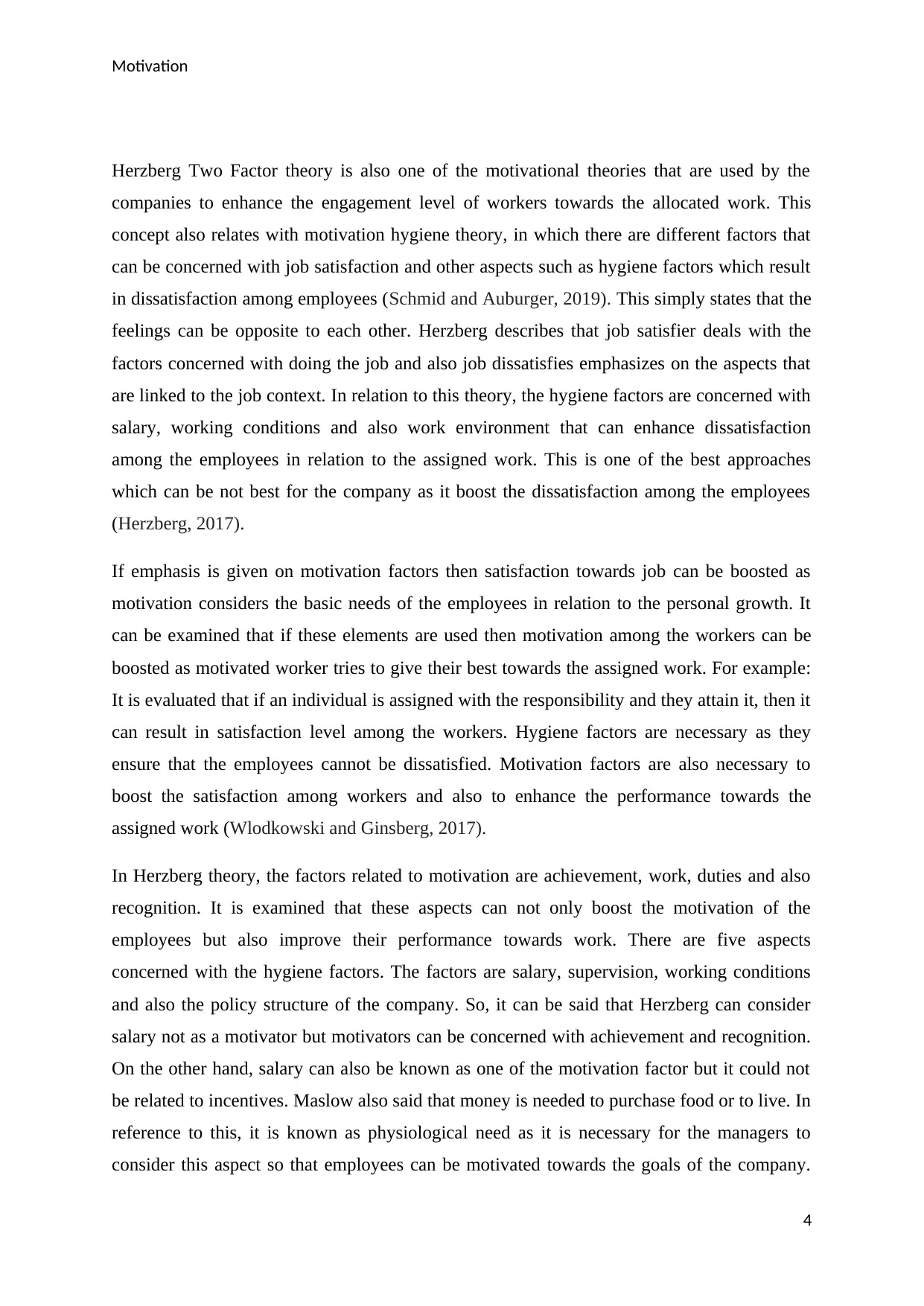
Motivation
Herzberg Two Factor theory is also one of the motivational theories that are used by the
companies to enhance the engagement level of workers towards the allocated work. This
concept also relates with motivation hygiene theory, in which there are different factors that
can be concerned with job satisfaction and other aspects such as hygiene factors which result
in dissatisfaction among employees (Schmid and Auburger, 2019). This simply states that the
feelings can be opposite to each other. Herzberg describes that job satisfier deals with the
factors concerned with doing the job and also job dissatisfies emphasizes on the aspects that
are linked to the job context. In relation to this theory, the hygiene factors are concerned with
salary, working conditions and also work environment that can enhance dissatisfaction
among the employees in relation to the assigned work. This is one of the best approaches
which can be not best for the company as it boost the dissatisfaction among the employees
(Herzberg, 2017).
If emphasis is given on motivation factors then satisfaction towards job can be boosted as
motivation considers the basic needs of the employees in relation to the personal growth. It
can be examined that if these elements are used then motivation among the workers can be
boosted as motivated worker tries to give their best towards the assigned work. For example:
It is evaluated that if an individual is assigned with the responsibility and they attain it, then it
can result in satisfaction level among the workers. Hygiene factors are necessary as they
ensure that the employees cannot be dissatisfied. Motivation factors are also necessary to
boost the satisfaction among workers and also to enhance the performance towards the
assigned work (Wlodkowski and Ginsberg, 2017).
In Herzberg theory, the factors related to motivation are achievement, work, duties and also
recognition. It is examined that these aspects can not only boost the motivation of the
employees but also improve their performance towards work. There are five aspects
concerned with the hygiene factors. The factors are salary, supervision, working conditions
and also the policy structure of the company. So, it can be said that Herzberg can consider
salary not as a motivator but motivators can be concerned with achievement and recognition.
On the other hand, salary can also be known as one of the motivation factor but it could not
be related to incentives. Maslow also said that money is needed to purchase food or to live. In
reference to this, it is known as physiological need as it is necessary for the managers to
consider this aspect so that employees can be motivated towards the goals of the company.
4
Herzberg Two Factor theory is also one of the motivational theories that are used by the
companies to enhance the engagement level of workers towards the allocated work. This
concept also relates with motivation hygiene theory, in which there are different factors that
can be concerned with job satisfaction and other aspects such as hygiene factors which result
in dissatisfaction among employees (Schmid and Auburger, 2019). This simply states that the
feelings can be opposite to each other. Herzberg describes that job satisfier deals with the
factors concerned with doing the job and also job dissatisfies emphasizes on the aspects that
are linked to the job context. In relation to this theory, the hygiene factors are concerned with
salary, working conditions and also work environment that can enhance dissatisfaction
among the employees in relation to the assigned work. This is one of the best approaches
which can be not best for the company as it boost the dissatisfaction among the employees
(Herzberg, 2017).
If emphasis is given on motivation factors then satisfaction towards job can be boosted as
motivation considers the basic needs of the employees in relation to the personal growth. It
can be examined that if these elements are used then motivation among the workers can be
boosted as motivated worker tries to give their best towards the assigned work. For example:
It is evaluated that if an individual is assigned with the responsibility and they attain it, then it
can result in satisfaction level among the workers. Hygiene factors are necessary as they
ensure that the employees cannot be dissatisfied. Motivation factors are also necessary to
boost the satisfaction among workers and also to enhance the performance towards the
assigned work (Wlodkowski and Ginsberg, 2017).
In Herzberg theory, the factors related to motivation are achievement, work, duties and also
recognition. It is examined that these aspects can not only boost the motivation of the
employees but also improve their performance towards work. There are five aspects
concerned with the hygiene factors. The factors are salary, supervision, working conditions
and also the policy structure of the company. So, it can be said that Herzberg can consider
salary not as a motivator but motivators can be concerned with achievement and recognition.
On the other hand, salary can also be known as one of the motivation factor but it could not
be related to incentives. Maslow also said that money is needed to purchase food or to live. In
reference to this, it is known as physiological need as it is necessary for the managers to
consider this aspect so that employees can be motivated towards the goals of the company.
4
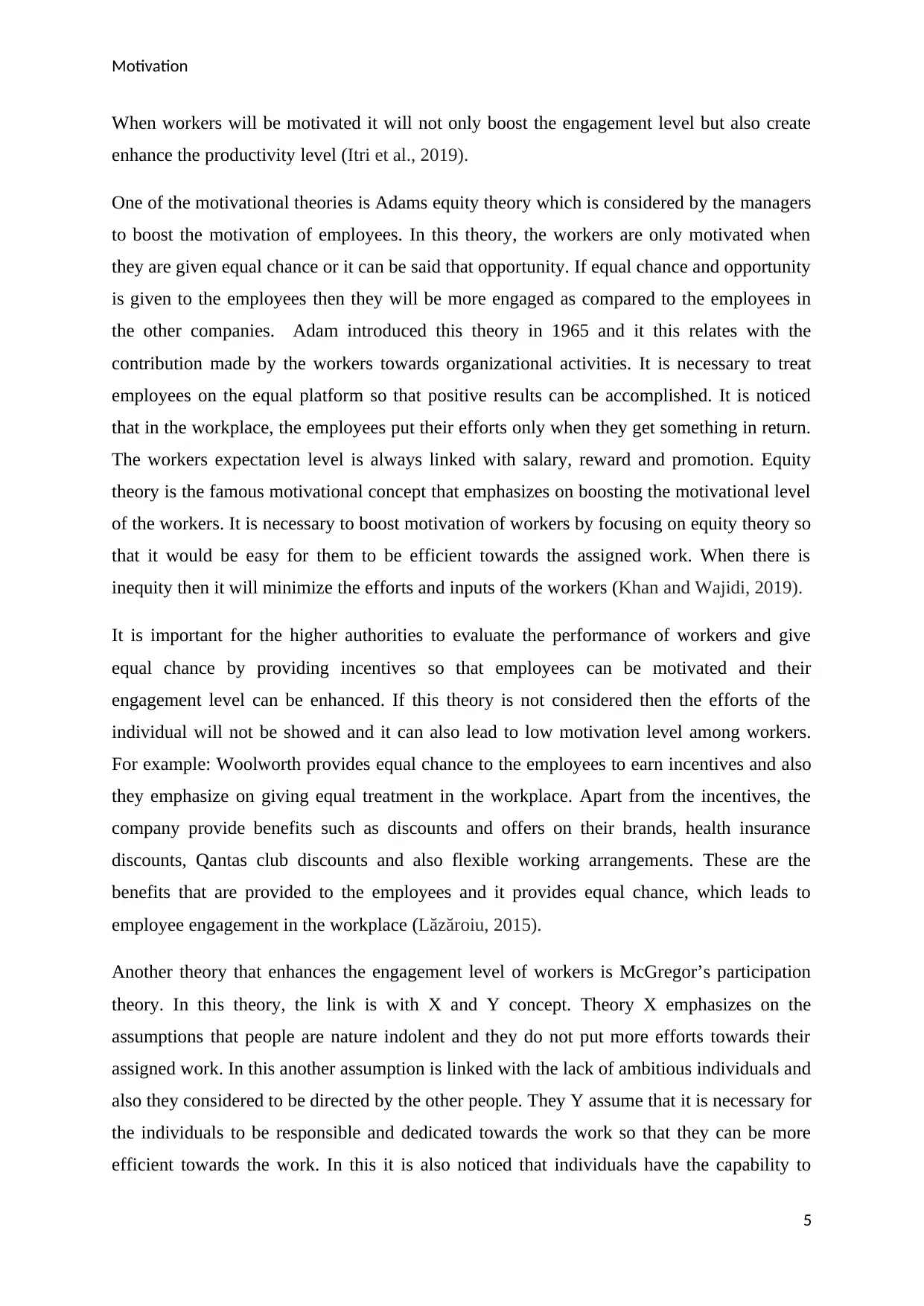
Motivation
When workers will be motivated it will not only boost the engagement level but also create
enhance the productivity level (Itri et al., 2019).
One of the motivational theories is Adams equity theory which is considered by the managers
to boost the motivation of employees. In this theory, the workers are only motivated when
they are given equal chance or it can be said that opportunity. If equal chance and opportunity
is given to the employees then they will be more engaged as compared to the employees in
the other companies. Adam introduced this theory in 1965 and it this relates with the
contribution made by the workers towards organizational activities. It is necessary to treat
employees on the equal platform so that positive results can be accomplished. It is noticed
that in the workplace, the employees put their efforts only when they get something in return.
The workers expectation level is always linked with salary, reward and promotion. Equity
theory is the famous motivational concept that emphasizes on boosting the motivational level
of the workers. It is necessary to boost motivation of workers by focusing on equity theory so
that it would be easy for them to be efficient towards the assigned work. When there is
inequity then it will minimize the efforts and inputs of the workers (Khan and Wajidi, 2019).
It is important for the higher authorities to evaluate the performance of workers and give
equal chance by providing incentives so that employees can be motivated and their
engagement level can be enhanced. If this theory is not considered then the efforts of the
individual will not be showed and it can also lead to low motivation level among workers.
For example: Woolworth provides equal chance to the employees to earn incentives and also
they emphasize on giving equal treatment in the workplace. Apart from the incentives, the
company provide benefits such as discounts and offers on their brands, health insurance
discounts, Qantas club discounts and also flexible working arrangements. These are the
benefits that are provided to the employees and it provides equal chance, which leads to
employee engagement in the workplace (Lăzăroiu, 2015).
Another theory that enhances the engagement level of workers is McGregor’s participation
theory. In this theory, the link is with X and Y concept. Theory X emphasizes on the
assumptions that people are nature indolent and they do not put more efforts towards their
assigned work. In this another assumption is linked with the lack of ambitious individuals and
also they considered to be directed by the other people. They Y assume that it is necessary for
the individuals to be responsible and dedicated towards the work so that they can be more
efficient towards the work. In this it is also noticed that individuals have the capability to
5
When workers will be motivated it will not only boost the engagement level but also create
enhance the productivity level (Itri et al., 2019).
One of the motivational theories is Adams equity theory which is considered by the managers
to boost the motivation of employees. In this theory, the workers are only motivated when
they are given equal chance or it can be said that opportunity. If equal chance and opportunity
is given to the employees then they will be more engaged as compared to the employees in
the other companies. Adam introduced this theory in 1965 and it this relates with the
contribution made by the workers towards organizational activities. It is necessary to treat
employees on the equal platform so that positive results can be accomplished. It is noticed
that in the workplace, the employees put their efforts only when they get something in return.
The workers expectation level is always linked with salary, reward and promotion. Equity
theory is the famous motivational concept that emphasizes on boosting the motivational level
of the workers. It is necessary to boost motivation of workers by focusing on equity theory so
that it would be easy for them to be efficient towards the assigned work. When there is
inequity then it will minimize the efforts and inputs of the workers (Khan and Wajidi, 2019).
It is important for the higher authorities to evaluate the performance of workers and give
equal chance by providing incentives so that employees can be motivated and their
engagement level can be enhanced. If this theory is not considered then the efforts of the
individual will not be showed and it can also lead to low motivation level among workers.
For example: Woolworth provides equal chance to the employees to earn incentives and also
they emphasize on giving equal treatment in the workplace. Apart from the incentives, the
company provide benefits such as discounts and offers on their brands, health insurance
discounts, Qantas club discounts and also flexible working arrangements. These are the
benefits that are provided to the employees and it provides equal chance, which leads to
employee engagement in the workplace (Lăzăroiu, 2015).
Another theory that enhances the engagement level of workers is McGregor’s participation
theory. In this theory, the link is with X and Y concept. Theory X emphasizes on the
assumptions that people are nature indolent and they do not put more efforts towards their
assigned work. In this another assumption is linked with the lack of ambitious individuals and
also they considered to be directed by the other people. They Y assume that it is necessary for
the individuals to be responsible and dedicated towards the work so that they can be more
efficient towards the work. In this it is also noticed that individuals have the capability to
5
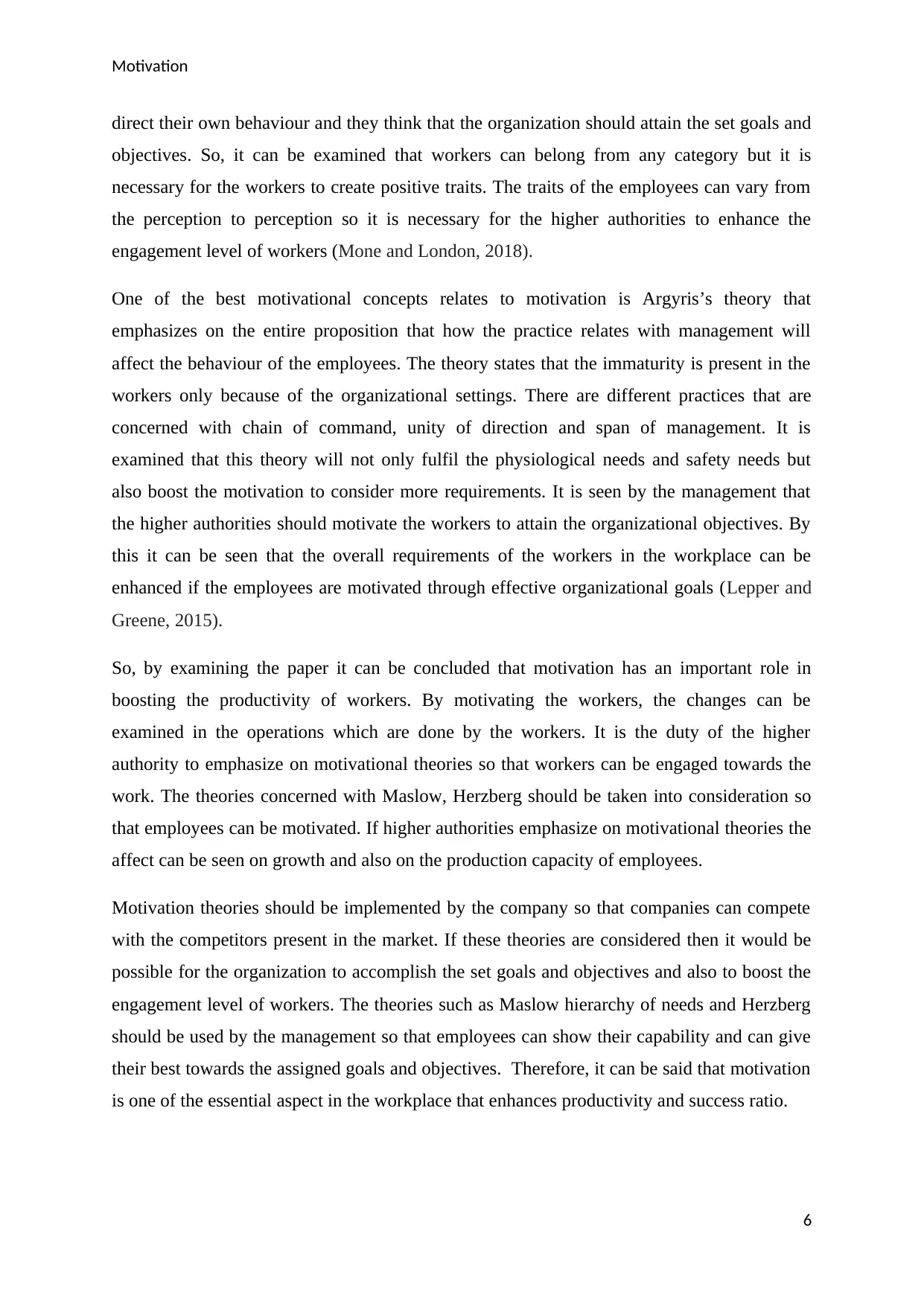
Motivation
direct their own behaviour and they think that the organization should attain the set goals and
objectives. So, it can be examined that workers can belong from any category but it is
necessary for the workers to create positive traits. The traits of the employees can vary from
the perception to perception so it is necessary for the higher authorities to enhance the
engagement level of workers (Mone and London, 2018).
One of the best motivational concepts relates to motivation is Argyris’s theory that
emphasizes on the entire proposition that how the practice relates with management will
affect the behaviour of the employees. The theory states that the immaturity is present in the
workers only because of the organizational settings. There are different practices that are
concerned with chain of command, unity of direction and span of management. It is
examined that this theory will not only fulfil the physiological needs and safety needs but
also boost the motivation to consider more requirements. It is seen by the management that
the higher authorities should motivate the workers to attain the organizational objectives. By
this it can be seen that the overall requirements of the workers in the workplace can be
enhanced if the employees are motivated through effective organizational goals (Lepper and
Greene, 2015).
So, by examining the paper it can be concluded that motivation has an important role in
boosting the productivity of workers. By motivating the workers, the changes can be
examined in the operations which are done by the workers. It is the duty of the higher
authority to emphasize on motivational theories so that workers can be engaged towards the
work. The theories concerned with Maslow, Herzberg should be taken into consideration so
that employees can be motivated. If higher authorities emphasize on motivational theories the
affect can be seen on growth and also on the production capacity of employees.
Motivation theories should be implemented by the company so that companies can compete
with the competitors present in the market. If these theories are considered then it would be
possible for the organization to accomplish the set goals and objectives and also to boost the
engagement level of workers. The theories such as Maslow hierarchy of needs and Herzberg
should be used by the management so that employees can show their capability and can give
their best towards the assigned goals and objectives. Therefore, it can be said that motivation
is one of the essential aspect in the workplace that enhances productivity and success ratio.
6
direct their own behaviour and they think that the organization should attain the set goals and
objectives. So, it can be examined that workers can belong from any category but it is
necessary for the workers to create positive traits. The traits of the employees can vary from
the perception to perception so it is necessary for the higher authorities to enhance the
engagement level of workers (Mone and London, 2018).
One of the best motivational concepts relates to motivation is Argyris’s theory that
emphasizes on the entire proposition that how the practice relates with management will
affect the behaviour of the employees. The theory states that the immaturity is present in the
workers only because of the organizational settings. There are different practices that are
concerned with chain of command, unity of direction and span of management. It is
examined that this theory will not only fulfil the physiological needs and safety needs but
also boost the motivation to consider more requirements. It is seen by the management that
the higher authorities should motivate the workers to attain the organizational objectives. By
this it can be seen that the overall requirements of the workers in the workplace can be
enhanced if the employees are motivated through effective organizational goals (Lepper and
Greene, 2015).
So, by examining the paper it can be concluded that motivation has an important role in
boosting the productivity of workers. By motivating the workers, the changes can be
examined in the operations which are done by the workers. It is the duty of the higher
authority to emphasize on motivational theories so that workers can be engaged towards the
work. The theories concerned with Maslow, Herzberg should be taken into consideration so
that employees can be motivated. If higher authorities emphasize on motivational theories the
affect can be seen on growth and also on the production capacity of employees.
Motivation theories should be implemented by the company so that companies can compete
with the competitors present in the market. If these theories are considered then it would be
possible for the organization to accomplish the set goals and objectives and also to boost the
engagement level of workers. The theories such as Maslow hierarchy of needs and Herzberg
should be used by the management so that employees can show their capability and can give
their best towards the assigned goals and objectives. Therefore, it can be said that motivation
is one of the essential aspect in the workplace that enhances productivity and success ratio.
6
Paraphrase This Document
Need a fresh take? Get an instant paraphrase of this document with our AI Paraphraser
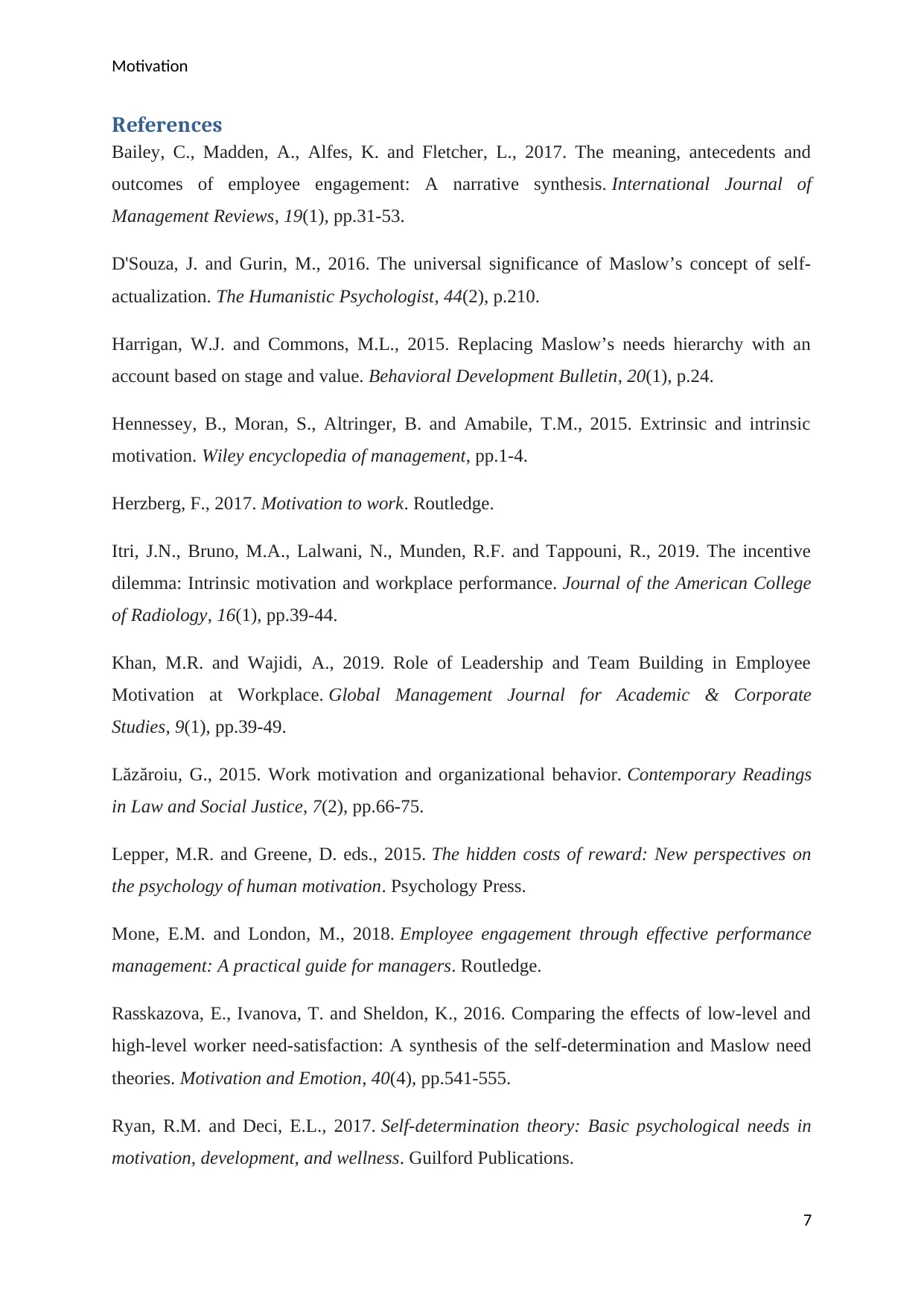
Motivation
References
Bailey, C., Madden, A., Alfes, K. and Fletcher, L., 2017. The meaning, antecedents and
outcomes of employee engagement: A narrative synthesis. International Journal of
Management Reviews, 19(1), pp.31-53.
D'Souza, J. and Gurin, M., 2016. The universal significance of Maslow’s concept of self-
actualization. The Humanistic Psychologist, 44(2), p.210.
Harrigan, W.J. and Commons, M.L., 2015. Replacing Maslow’s needs hierarchy with an
account based on stage and value. Behavioral Development Bulletin, 20(1), p.24.
Hennessey, B., Moran, S., Altringer, B. and Amabile, T.M., 2015. Extrinsic and intrinsic
motivation. Wiley encyclopedia of management, pp.1-4.
Herzberg, F., 2017. Motivation to work. Routledge.
Itri, J.N., Bruno, M.A., Lalwani, N., Munden, R.F. and Tappouni, R., 2019. The incentive
dilemma: Intrinsic motivation and workplace performance. Journal of the American College
of Radiology, 16(1), pp.39-44.
Khan, M.R. and Wajidi, A., 2019. Role of Leadership and Team Building in Employee
Motivation at Workplace. Global Management Journal for Academic & Corporate
Studies, 9(1), pp.39-49.
Lăzăroiu, G., 2015. Work motivation and organizational behavior. Contemporary Readings
in Law and Social Justice, 7(2), pp.66-75.
Lepper, M.R. and Greene, D. eds., 2015. The hidden costs of reward: New perspectives on
the psychology of human motivation. Psychology Press.
Mone, E.M. and London, M., 2018. Employee engagement through effective performance
management: A practical guide for managers. Routledge.
Rasskazova, E., Ivanova, T. and Sheldon, K., 2016. Comparing the effects of low-level and
high-level worker need-satisfaction: A synthesis of the self-determination and Maslow need
theories. Motivation and Emotion, 40(4), pp.541-555.
Ryan, R.M. and Deci, E.L., 2017. Self-determination theory: Basic psychological needs in
motivation, development, and wellness. Guilford Publications.
7
References
Bailey, C., Madden, A., Alfes, K. and Fletcher, L., 2017. The meaning, antecedents and
outcomes of employee engagement: A narrative synthesis. International Journal of
Management Reviews, 19(1), pp.31-53.
D'Souza, J. and Gurin, M., 2016. The universal significance of Maslow’s concept of self-
actualization. The Humanistic Psychologist, 44(2), p.210.
Harrigan, W.J. and Commons, M.L., 2015. Replacing Maslow’s needs hierarchy with an
account based on stage and value. Behavioral Development Bulletin, 20(1), p.24.
Hennessey, B., Moran, S., Altringer, B. and Amabile, T.M., 2015. Extrinsic and intrinsic
motivation. Wiley encyclopedia of management, pp.1-4.
Herzberg, F., 2017. Motivation to work. Routledge.
Itri, J.N., Bruno, M.A., Lalwani, N., Munden, R.F. and Tappouni, R., 2019. The incentive
dilemma: Intrinsic motivation and workplace performance. Journal of the American College
of Radiology, 16(1), pp.39-44.
Khan, M.R. and Wajidi, A., 2019. Role of Leadership and Team Building in Employee
Motivation at Workplace. Global Management Journal for Academic & Corporate
Studies, 9(1), pp.39-49.
Lăzăroiu, G., 2015. Work motivation and organizational behavior. Contemporary Readings
in Law and Social Justice, 7(2), pp.66-75.
Lepper, M.R. and Greene, D. eds., 2015. The hidden costs of reward: New perspectives on
the psychology of human motivation. Psychology Press.
Mone, E.M. and London, M., 2018. Employee engagement through effective performance
management: A practical guide for managers. Routledge.
Rasskazova, E., Ivanova, T. and Sheldon, K., 2016. Comparing the effects of low-level and
high-level worker need-satisfaction: A synthesis of the self-determination and Maslow need
theories. Motivation and Emotion, 40(4), pp.541-555.
Ryan, R.M. and Deci, E.L., 2017. Self-determination theory: Basic psychological needs in
motivation, development, and wellness. Guilford Publications.
7
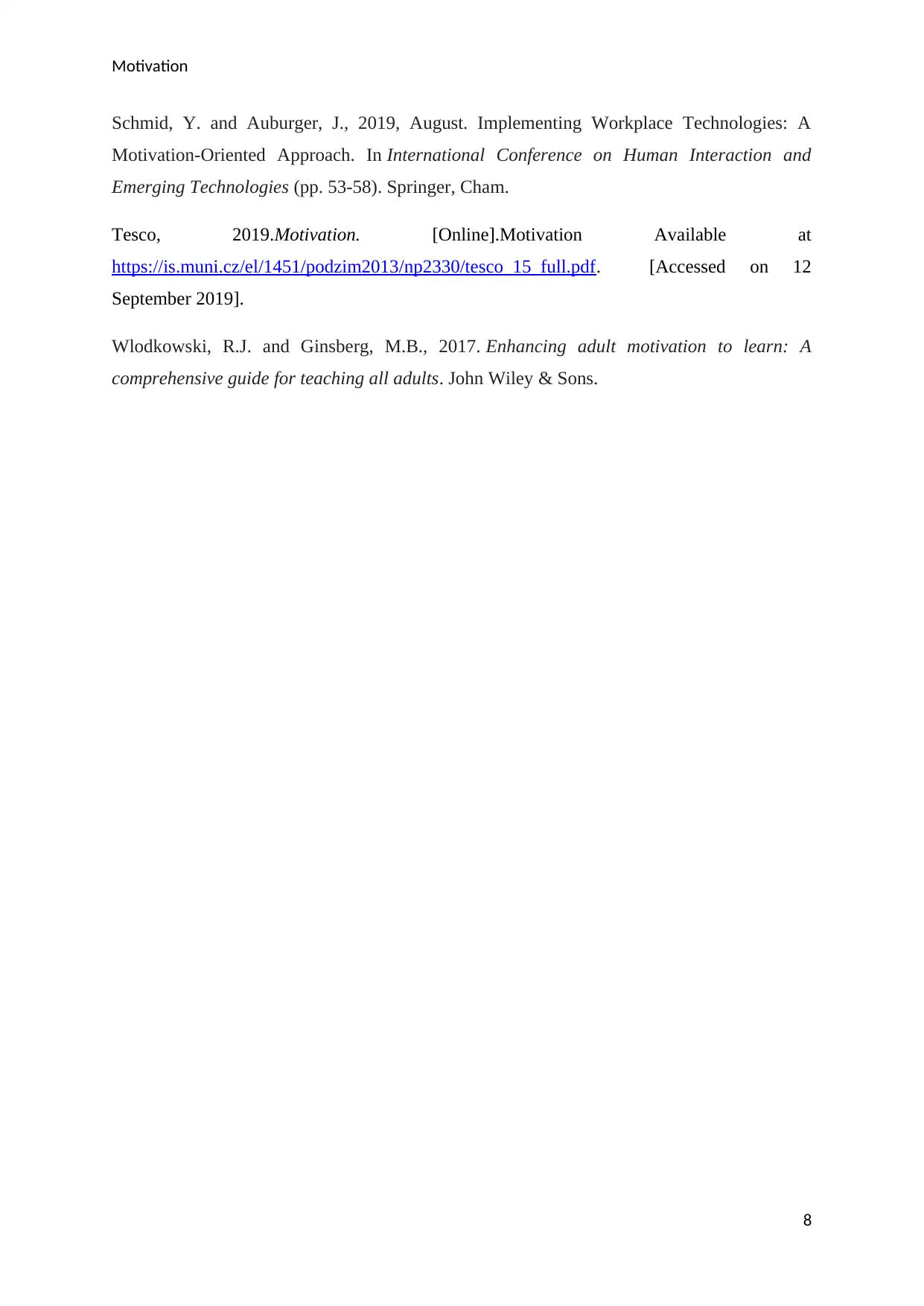
Motivation
Schmid, Y. and Auburger, J., 2019, August. Implementing Workplace Technologies: A
Motivation-Oriented Approach. In International Conference on Human Interaction and
Emerging Technologies (pp. 53-58). Springer, Cham.
Tesco, 2019.Motivation. [Online].Motivation Available at
https://is.muni.cz/el/1451/podzim2013/np2330/tesco_15_full.pdf. [Accessed on 12
September 2019].
Wlodkowski, R.J. and Ginsberg, M.B., 2017. Enhancing adult motivation to learn: A
comprehensive guide for teaching all adults. John Wiley & Sons.
8
Schmid, Y. and Auburger, J., 2019, August. Implementing Workplace Technologies: A
Motivation-Oriented Approach. In International Conference on Human Interaction and
Emerging Technologies (pp. 53-58). Springer, Cham.
Tesco, 2019.Motivation. [Online].Motivation Available at
https://is.muni.cz/el/1451/podzim2013/np2330/tesco_15_full.pdf. [Accessed on 12
September 2019].
Wlodkowski, R.J. and Ginsberg, M.B., 2017. Enhancing adult motivation to learn: A
comprehensive guide for teaching all adults. John Wiley & Sons.
8
1 out of 9
Related Documents
Your All-in-One AI-Powered Toolkit for Academic Success.
+13062052269
info@desklib.com
Available 24*7 on WhatsApp / Email
![[object Object]](/_next/static/media/star-bottom.7253800d.svg)
Unlock your academic potential
© 2024 | Zucol Services PVT LTD | All rights reserved.





